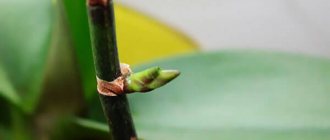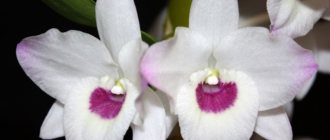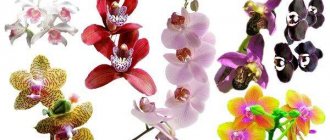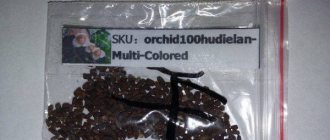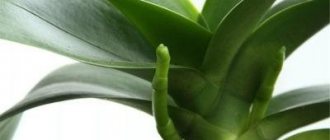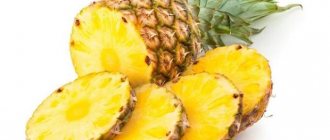Propagation of orchids by peduncles is the easiest way to obtain a new plant. After prolonged flowering, the orchid flowers dry out and fall off, then small plants - babies - often develop on the flower stalk. They are quite easily separated from the mother orchid and take root. This method can be considered the easiest to obtain a new plant. Next, you will learn how to grow an orchid from a peduncle.
Caring for a plant to produce babies
The baby (shoot) of an orchid is a fully formed, miniature plant with leaves, stem and roots.
Phalaenopsis orchid babies.
In order for children to form on the peduncle, after the end of the flowering period, the arrow must be shortened to a height of 1.5-2 cm above the upper dormant bud. As a rule, children develop on their own; for this it is only necessary to create optimal conditions for the plant:
- a large amount of bright diffused light;
- quite high daytime temperature – about +27-30℃. If you want a flower shoot to form from dormant buds, the room temperature should be no more than 24℃;
- Poor watering of the plant is combined with high humidity (60-80%). To do this, the orchid is regularly sprayed and placed on a tray with wet sand or moss.
Having created the necessary conditions, it is quite easy to awaken dormant buds and cause the appearance of children.
Recommendations and contraindications
Cytokinin paste is an effective stimulant that can awaken dormant buds, activate growth and normalize metabolism, and it also helps restore the normal functioning of the plant after experiencing stress.
However, before using it, you should carefully read the instructions for use and be sure to take into account possible contraindications.
Recommendations for use:
- the paste must be warmed to room temperature;
- select several healthy buds on the peduncle (no more than 3!);
- Use a scalpel or tweezers to separate the upper semicircular scale;
- treat the opened area with water, and then apply cytokinin paste in an even layer.
Main contraindications:
- the orchid was recently transplanted and adaptation to the new soil has not yet been completed;
- flowering period;
- the plant has been exposed to hypothermia, weakened or damaged by harmful organisms;
- too young, underdeveloped plant.
If all the necessary recommendations are followed, the result will not take long to arrive; the first changes will be noticeable within a week.
We invite you to watch a video about cytokinin paste and its use to awaken the kidney:
Timing for vegetative propagation
After the end of the flowering phase, the best period for the development of children begins. In this case, the following requirements are imposed on an adult plant:
- the orchid must have a developed root system and at least 2 pairs of large leaves;
- it must be in the final flowering phase;
- The best time of year is spring or early summer.
In low humidity or low light conditions, which is typical for the autumn-winter period at home, babies do not form on the peduncle.
How to propagate Phalaenopsis
Of course, I would like to have such beauty in more than one copy. If you only have one orchid, you can get several from it!
It is also necessary to propagate an orchid when the bush is already old. With proper care and high-quality substrate, Phalaenopsis can live a very long time. When aging, you just need to update them by cutting off the top and planting it in a new substrate.
The old bush can be divided
Phalaenopsis can only be propagated from an adult plant. It must have at least five healthy leaves, a developed root system and be at least three years old.
Reproduction methods:
- children;
- sockets;
- seeds.
The simplest of them are propagation by children and division of the rosette.
The sometimes indicated method of propagation by “peduncle” is nothing more than propagation by children.
Mandatory conditions for various methods of reproduction:
- instruments must be sterilized;
- all sections must be treated with an antiseptic (activated carbon, turmeric or brilliant green);
- The water should be boiled and warm.
With any method of propagation, the orchid must be provided with good care, and before and after flowering it must be fed with potassium-phosphorus fertilizer.
It is best to use ready-made fertilizers for orchids, then you will not make a mistake in the dosage.
Stimulation: use of cytokinin paste
A paste based on the phytohormone cytokinin is a preparation that is widely used in floriculture. It actively influences plant cell division, awakening dormant buds, and stimulates growth and flowering.
Its application is as follows:
- on a faded peduncle, choose a dormant bud, the uppermost or lower one, as they give a more predictable result;
- with a sharp object (knife, scalpel, needle), cut the dense scales on the kidney;
- Using tweezers, remove the cut off parts of the scale. A small bright green dot will open under them - a bud with which we will work;
- Apply a little paste onto it with a cotton swab (a ball about 2 mm in diameter). For better penetration of the drug, the kidney can first be slightly scratched with a needle. All manipulations are carried out very accurately;
- The surface of the kidney is completely and evenly lubricated with the paste.
Stimulation of a dormant kidney with cytokinin paste.
Attention! It is not recommended to treat more than two dormant buds on a peduncle with cytokinin.
7-10 days after applying the paste, you can expect the first signs of a growing baby or flowering shoot to appear.
How to understand what has appeared?
When it first appears on a flower, it is quite difficult to distinguish the baby from a peduncle or an aerial root
Therefore, it is important to know what the root, peduncle and the baby itself look like
- Root – has a smooth surface without scales with rounded tips. Pointed downwards. Growth to the side or upward can be observed quite rarely.
- Peduncle - grows from the center upward and has a sharp tip. It, unlike the root, has scales.
- The baby is a new small plant with its own leaves and roots. But in order to be completely sure that this is a new plant, you need to wait. It is after the leaves appear that it will become clear that the orchid has given birth to offspring.
On the root
At first glance, it will seem that an independent plant is growing at the root. But if you carefully rake the upper part of the bark, you will see that a small plant has appeared on the mother plant. In order to separate the baby from the root of an adult plant, it is necessary to cut off the baby along with its piece. However, you should not do this until the baby has its own roots.
Popular articles Description and features of the use of the folded talker mushroom
It is worth separating it with special care, as there is a risk of damaging the roots of the mother plant and the baby itself. Many gardeners prefer not to separate it from the root of an adult plant. In this case, if you provide proper care, both beauties will give beautiful blooms.
We invite you to watch a video about the appearance of a baby on an orchid root:
On the trunk
Many experts believe that there are several reasons for the appearance of children:
- Improper care, due to which the flower dies, devotes its last strength to reproduction, fulfilling its biological task. But in practice it turns out differently. The baby can appear on the stem of a completely healthy flower.
- Injury to the stem or death of a growing point are the following reasons for the appearance of babies on the stem.
You should not separate the baby from the mother. She won't survive on her own. As a result, there will be two orchids in one pot. The mother plant dies over time, and its place is taken by a young one.
Attention! A feature of the basal shoot is that the baby has no roots; it feeds on the roots and stems of the mother plant.
But some gardeners still resort to the procedure of separating the baby from the stem. During this process, the following rules must be followed:
- Be sure to sprinkle the cut area with charcoal;
- Dry the young plant for a day and then place it in a fine-grained substrate;
- expect roots to appear.
At the base of the root collar
- Before separating such a baby, you must first prepare the equipment. Afterwards you need to cut the baby from the plant. But do not cut it off completely, but leave at least one centimeter of the peduncle.
- Then the cut shoot is dried for 30 minutes.
- The cut is sprinkled with charcoal or activated carbon.
- The shoot is placed in the prepared substrate.
When can I place my older child?
After six months, the baby forms 2 pairs of leaves and roots.
Attention! Very small roots cannot ensure good survival of the baby after transplantation. It is better to delay its separation from the peduncle until the roots grow.
When the baby forms 3-4 roots about five centimeters long , it is separated from the peduncle and planted in a separate pot.
Do you need to take action?
The florist will make the decision independently. Watch the baby, and if 4 months after the appearance of the layer the beginnings of roots have not appeared on it, then it’s time to think about how to help the young plant.
You should not plant the baby in a separate pot without roots, since 80% of the time it will not survive, so before separating the cuttings, try to make sure that roots appear on it.
But if this option seems impracticable, then you can try to grow roots on a separated plant. At the same time, the process, although labor-intensive, gives very good results. Moreover, there are several ways. Therefore, you need to consider several options and choose the most suitable one.
Growing an orchid from a cut peduncle
Flower growers often wonder whether it is possible to grow orchid babies from a cut peduncle. Can. For this:
- The peduncle is cut off and placed in a container with settled water so that its base is immersed in water by 4-7 cm. Instead of water, you can use a 0.005% solution of complex mineral fertilizer;
- perform all the manipulations to awaken the dormant kidney using cytokinin paste . In this case, the peduncle is taken out of the container, then the cut is renewed, the water in the container is changed ;
- the flower-bearing arrow together with the vessel is covered with a plastic bag .
Growing a baby from a cut peduncle.
The plant is placed in a well-lit place. The further development of the baby proceeds in the same way as on the mother orchid.
How to properly build up in different ways?
If roots do not grow on the children, you can use both natural and artificial methods of extension.
Artificial
This method involves separating the baby from the mother, and only then growing roots. There are several options for this method; let’s look at the most effective ones, which are used by experienced gardeners at home.
In polystyrene foam
The young plant is supposed to float on water in a piece of foam. The first step is to separate the baby from the mother orchid. It is worth remembering that cutting must be done with a sterile instrument and with a part of the peduncle, approximately 2 cm.
Take a piece of foam plastic of the required size and make a hole in it. Then place the baby in the recess on the material, and it must be secured well. You can do this as follows:
- After the young orchid is inserted into the foam, several skewers are placed around it, which are used to prepare canapés.
- Then stretch any thick thread between them, so that the leaves rest well on it.
Take a small container, pour warm water into it and let out a circle of foam plastic, with the baby
In this case, it is important to ensure that the plant does not touch the water, so it is advisable to take polystyrene foam of the proper thickness. The distance from the base of the plant to the water should be at least 3-5 mm. If you do not comply with this requirement, then the base of the baby may simply rot.
There is no effect from the structure; you can plant the plant closer to the water, about 1 mm. Perhaps such close proximity will stimulate the growth of the root system
If you do not comply with this requirement, then the base of the baby may simply rot. There is no effect from the structure; you can plant the plant closer to the water, about 1 mm. Perhaps such close proximity will stimulate the growth of the root system.
We invite you to watch a video about growing roots in water with polystyrene foam:
In the greenhouse
In order for the baby to grow roots faster, it needs to be placed in conditions that match the habitat of this exotic flower - the tropics with high humidity. We'll have to build a mini-greenhouse. To do this you should prepare:
- small plastic cup;
- some drainage material;
- sphagnum moss;
- plastic bag;
- plastic bottle.
Once everything is ready, you can proceed:
- make several drainage holes in the cup - excess liquid will drain through them and air will pass through;
- place drainage on the bottom of the cup;
- sprinkle some moss;
- Make two opposite holes at the top of the container for support;
- set the plant so that the baby stands on a support and the leaves rest on the edges of the cup;
- cut the bottom of a plastic bottle and place it on a glass with a plant.
The greenhouse is ready, now you should place it in a well-lit place.
Air the baby daily by raising the bottle for a few minutes. You need to spray the plant 2 times a week, but so that the ox does not get into the area from which the roots should appear. Experienced flower growers advise adding a complex of fertilizers to the water twice a month.
The moss in the cup cannot be compacted - it must be loose and airy.
We invite you to watch a video on how to grow roots for a baby orchid in a greenhouse:
Natural
A method in which a baby’s roots are grown without separating her from her mother. The algorithm of actions is as follows:
- Buy sphagnum moss and soak it in warm water for about half an hour.
- As soon as it swells well, form a small nest out of it.
- Wrap the base of the baby with moss so that it does not fall; you can attach it with a thread. This must be done very carefully, as the baby is very delicate and can be easily damaged.
- Take a stick-stand and secure the peduncle so that the heavy arrow does not fall and break off.
If the air in the apartment is dry, then you need to wrap the moss with the baby in cling film or put a plastic bag on the peduncle to create a greenhouse effect. Don’t forget to remove the bag daily to ventilate the cuttings.
The moss is sprayed every day, with “Kornevin” – a root growth stimulator – added to the water.
As soon as roots 5 cm long appear, you can start planting the baby.
Landing in the ground
For planting, you can use a small glass made of transparent plastic, in which holes for drainage have been made in advance. Its volume must correspond to the size of the root system.
You can prepare the substrate yourself from the following ingredients:
- boiled pieces of pine bark no larger than 1 cm in size;
- sphagnum moss;
- charcoal.
Everything is mixed in equal parts.
Ready-made substrate can also be purchased at a garden store ; the size of the bark pieces should be no more than 1 cm.
Proper pruning
You cannot simply take and separate an orchid shoot from an adult plant. In order not to harm either the mother flower or the baby, you need to carefully trim the baby, following some recommendations.
Regardless of where the babies appeared on the orchid, pruning is carried out with a very sharp instrument, which must be pre-treated with an alcohol solution, vodka or other disinfectant.
Tools for separating and transplanting orchid babies:
- Sharp scissors (you can use a sharp knife or pruning shears).
- Prepare a suitable substrate.
- A suitable container for transplanting.
- Crushed activated carbon, or cinnamon.
- Latex gloves.
- Alcohol (wipe the tool you will use to separate the baby).
You need to prepare charcoal or cinnamon powder in advance. Activated carbon from a pharmacy will also work, but it will need to be crushed first. This powder is required to process all the cuts that have formed on both the baby and the parent.
Step-by-step instruction
Now you can separate the sprout from the trunk and replant it
Carefully separate the shoot from the mother stem. Using a sharp tool, cut off the cake with part of the peduncle
A peduncle of at least 1 cm should remain at the base of the sprout. If the orchid has sprouted a root child, before transplanting the sprout, make sure that the new plant has already formed its root system. Then it must be carefully separated with a sharp instrument and replanted.
Before transplanting the shoot, be sure to air dry the cut areas (half an hour), then sprinkle with cinnamon or crushed charcoal. Make drainage holes in a plastic pot (it should be transparent). Replant the baby so that the root collar is level with the top edge of the container. When you pour in the chopped bark, make sure that the roots are not damaged.
It is important that the pot into which you are going to transplant the plant is small, a little cramped for an orchid. Fill the pot with soil, holding the shoot. Make sure the roots are completely covered with the substrate.
If the container is not enough, the roots can be left on top, but then they should be carefully covered with moss. Shake the pot a little or tap the container to allow the soil to settle. Do not crush the substrate with your fingers - you can damage the roots.
The orchid should be watered on the second or third day. This pause is needed to allow the cut made on the peduncle to dry. This way we protect the orchid from the possibility of infection with various diseases from the moist environment of bark and moss.
How long do babies live on phalaenopsis?
Phalaenopsis orchid babies develop for quite a long time. First, the kidney wakes up, and it is clear that something is growing from it. Then the first leaves appear. They are quite small compared to their parents.
And only then does the formation of roots begin. A baby is considered mature when it has several roots at least 5 cm long.
The time it takes for development may vary and depends on the microclimate and nutrition of the bush. On average, this time can be defined as 6 months. If during this time the baby has not fully developed and grown roots, then measures need to be taken.
Stimulation of root emergence
First of all, you need to try to stimulate their growth and force them to take root. There is one simple trick for this. You need to take a small amount of sphagnum moss, moisten it, and secure it in the place where the baby’s roots should grow. Wrap the outside with film or a bag to prevent moisture from evaporating.
You can periodically moisten the moss so that it does not dry out, not just with water, but with Kornevin’s solution. After 2-3 weeks you can evaluate the result. Of course, there will be no roots yet, but you can understand whether they have begun to develop or there is no result.
Features of formation
The orchid is unusual in many ways. It’s the same with reproduction - you never know where the offspring will be formed and how they will develop. However, this is not at all uncommon, but a completely natural process.
There is an opinion that offspring appear before the death of the flower. But this is only partly true. If the baby appeared on a peduncle, then it is quite logical that it will soon dry up. After all, the plant has already bloomed.
But if we are talking about a root baby, then there is no reason to worry. Such a baby phalaenopsis should not be considered a harbinger of something bad.
Main problems
If we grow babies from a peduncle, we may encounter various problems.
Does not produce a peduncle
Regular watering of the plant stimulates leaf growth, so a change in climate is necessary for the formation of a peduncle. First of all, create a period of drought:
- air temperature should not exceed 30℃;
- double the interval between waterings to achieve complete drying of the roots. After this, the orchid should stand without watering for another 4-5 days in a warm room, and up to 7 days in a cool room;
- at this time the plant is not sprayed or fed.
To stimulate the appearance of a peduncle, the orchid is subjected to drought.
The appearance of a flower-bearing arrow means the resumption of care, excluding feeding.
Children are not educated
The formation of children can be considered as an orchid’s response to unfavorable conditions. By creating a regime of poor watering against a background of high temperatures and humidity, you can achieve the development of children. If this does not help, the dormant kidney is treated with cytokinin paste.
The emerging shoot has dried up
Such a baby on the peduncle is removed . If there are other dormant buds on the peduncle, then you can try to awaken them by treating them with cytokinin paste, and then create the conditions necessary for the plant to develop.
The dried baby must be removed.
The roots of a young plant died
To stimulate the re-development of roots, a special technique is used using sphagnum moss, thread and film for food products:
- the moss is soaked in water until it swells;
- form a ball out of it, fastening it with thread;
- the resulting lump is attached with a thread under the base of the baby;
- every day the ball of moss is sprinkled with water, to which it is recommended to add “Kornevin” to stimulate root growth.
Attention! An orchid with moss tied to a peduncle may topple, so it is better to tie it to a support.
Usually, the roots of a child are formed within six months , after which the small plant is ready for replanting.
Proper pruning
You cannot simply take and separate an orchid shoot from an adult plant. In order not to harm either the mother flower or the baby, you need to carefully trim the baby, following some recommendations.
Regardless of where the babies appeared on the orchid, pruning is carried out with a very sharp instrument, which must be pre-treated with an alcohol solution, vodka or other disinfectant.
Tools for separating and transplanting orchid babies:
- Sharp scissors (you can use a sharp knife or pruning shears).
- Prepare a suitable substrate.
- A suitable container for transplanting.
- Crushed activated carbon, or cinnamon.
- Latex gloves.
- Alcohol (wipe the tool you will use to separate the baby).
You need to prepare charcoal or cinnamon powder in advance. Activated carbon from a pharmacy will also work, but it will need to be crushed first. This powder is required to process all the cuts that have formed on both the baby and the parent.
Step-by-step instruction
Now you can separate the sprout from the trunk and replant it
Carefully separate the shoot from the mother stem. Using a sharp tool, cut off the cake with part of the peduncle
A peduncle of at least 1 cm should remain at the base of the sprout. If the orchid has sprouted a root child, before transplanting the sprout, make sure that the new plant has already formed its root system. Then it must be carefully separated with a sharp instrument and replanted.
Before transplanting the shoot, be sure to air dry the cut areas (half an hour), then sprinkle with cinnamon or crushed charcoal. Make drainage holes in a plastic pot (it should be transparent). Replant the baby so that the root collar is level with the top edge of the container. When you pour in the chopped bark, make sure that the roots are not damaged.
It is important that the pot into which you are going to transplant the plant is small, a little cramped for an orchid. Fill the pot with soil, holding the shoot
Make sure that the roots are completely covered with the substrate. If the container is not enough, the roots can be left on top, but then they should be carefully covered with moss. Shake the pot a little or tap the container to allow the soil to settle. Do not crush the substrate with your fingers - you can damage the roots.
The orchid should be watered on the second or third day. This pause is needed to allow the cut made on the peduncle to dry. This way we protect the orchid from the possibility of infection with various diseases from the moist environment of bark and moss.
How long do babies live on phalaenopsis?
Phalaenopsis orchid babies develop for quite a long time. First, the kidney wakes up, and it is clear that something is growing from it. Then the first leaves appear. They are quite small compared to their parents.
And only then does the formation of roots begin. A baby is considered mature when it has several roots at least 5 cm long.
The time it takes for development may vary and depends on the microclimate and nutrition of the bush. On average, this time can be defined as 6 months. If during this time the baby has not fully developed and grown roots, then measures need to be taken.
Stimulation of root emergence
First of all, you need to try to stimulate their growth and force them to take root. There is one simple trick for this. You need to take a small amount of sphagnum moss, moisten it, and secure it in the place where the baby’s roots should grow. Wrap the outside with film or a bag to prevent moisture from evaporating.
You can periodically moisten the moss so that it does not dry out, not just with water, but with Kornevin’s solution. After 2-3 weeks you can evaluate the result. Of course, there will be no roots yet, but you can understand whether they have begun to develop or there is no result.
Features of formation
The orchid is unusual in many ways. It’s the same with reproduction - you never know where the offspring will be formed and how they will develop. However, this is not at all uncommon, but a completely natural process.
There is an opinion that offspring appear before the death of the flower. But this is only partly true. If the baby appeared on a peduncle, then it is quite logical that it will soon dry up. After all, the plant has already bloomed.
But if we are talking about a root baby, then there is no reason to worry. Such a baby phalaenopsis should not be considered a harbinger of something bad.
Where to buy flasks?
1. Bring from Thailand or other Asian countries.
2. Order directly from a large orchid breeder. There are special farms for forcing orchids in flasks. Delivery is carried out by mail or courier service.
3. Online stores or special forums for flower growers. Participants form a collective order for the purchase of a certain variety of orchids.
The price of flasks directly depends on the number of seedlings and varieties of orchids in it.
Adaptation of seedlings
Before planned transplantation, it is recommended to adapt the seedlings to the external environment.
The process is possible if the development of plants in the flask is normal . The nutritional gel is exactly at the bottom, and healthy and green shoots quietly grow from it.
Begin gradually accustoming the seedlings to new conditions.
At the beginning, open the lid for a couple of minutes , letting air into the flask, gradually increasing the airing time from five minutes to several hours.
Observe your pets’ reaction to changing circumstances, and if mold appears, remove it.
Unpleasant moments
Flask can be fraught with its own troubles:
- The flask may not be sealed.
Because of this, the hydrogel will darken and become covered with bacterial blackness, and possibly mold. Such a flask must be urgently opened and the plants must be disinfected. Plants may also freeze inside and all moisture may evaporate.
- The flask may be broken.
- The flask may contain too many plants and they begin to choke each other.


